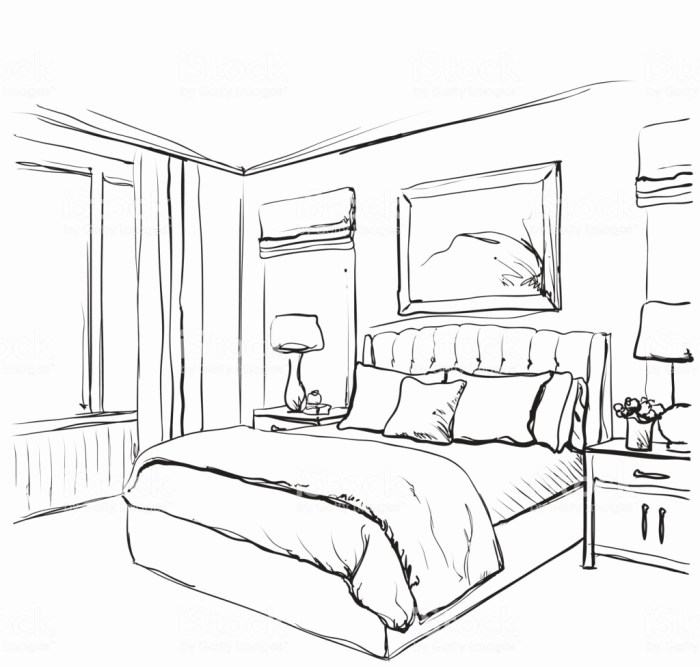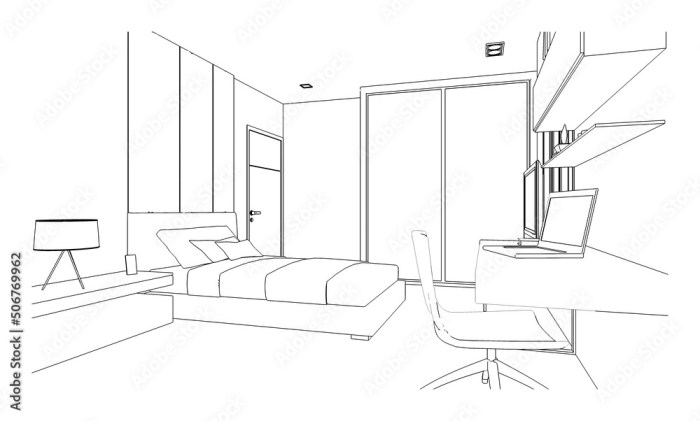Defining the Scope of “Easy Sketch”

Line drawing easy sketch of bedroom – An easy sketch of a bedroom, for a beginner, prioritizes simplicity and capturing the essence of the space over intricate detail. It’s about understanding basic shapes and conveying a sense of place, rather than photorealistic accuracy. This thread will explore what constitutes an “easy sketch” in this context.A simple line drawing, ideal for beginners, relies on basic shapes like rectangles, squares, and circles to represent furniture and architectural features.
Line weight is generally consistent, avoiding heavy shading or complex textures. The focus is on clear lines and a balanced composition, rather than fine details or sophisticated techniques.
Essential Elements in an Easy Bedroom Sketch
To create a recognizable bedroom sketch, certain key elements should be included. These elements provide context and help the viewer understand the space depicted. The level of detail within each element remains minimal, keeping the overall sketch easy to execute. For example, a bed might be a simple rectangle with a smaller rectangle on top representing the headboard.
A bedside table could be a square or a simple rectangle. A wardrobe could be represented by a tall, thin rectangle. These simplified forms still convey the intended objects effectively.
Distinguishing Simple Sketches from Detailed Drawings
The key difference between a simple sketch and a detailed drawing lies in the level of detail and the techniques employed. A simple sketch uses basic shapes and lines to represent objects, prioritizing clarity and speed. It often lacks shading, texture, or intricate details. Conversely, a detailed drawing incorporates shading, perspective, textures, and fine details to create a realistic representation of the scene.
It might include subtle variations in line weight, detailed textures on fabrics, and accurate rendering of light and shadow. A simple sketch of a bedroom might show a bed, a wardrobe, and a window with a few simple lines; a detailed drawing would depict the bedspread’s texture, the wood grain of the wardrobe, and the light streaming through the window with realistic shading.
Basic Shapes and Forms in Bedroom Sketches: Line Drawing Easy Sketch Of Bedroom

Creating a simple yet effective line drawing of a bedroom relies heavily on understanding and utilizing basic geometric shapes. By breaking down complex furniture and room features into their fundamental components, you can achieve a satisfying sketch with minimal effort. This approach simplifies the drawing process and allows you to focus on capturing the essence of the space.
We’ll explore how simple shapes like squares, rectangles, and circles form the foundation of common bedroom furniture. Mastering this technique allows for quick and easy sketching, perfect for capturing quick ideas or practicing your drawing skills.
Representing Bedroom Furniture with Basic Shapes
Imagine a bed. Instead of attempting to draw all the intricate details immediately, visualize it as a large rectangle for the mattress, topped by a slightly smaller rectangle representing the headboard. A simple square or rectangle suffices for the nightstand. The wardrobe can be represented as a tall rectangle, possibly with a smaller rectangle added on top to represent the top section or drawers.
These basic shapes provide a solid framework for your sketch, making it easier to add finer details later.
Yo, so I’m totally into these chill line drawings, like, sketching my bedroom is low-key my jam. It’s all about simple lines and shapes, ya know? Then I saw this sick tutorial on justinian emperor easy drawing , which got me thinking about different styles. Now I’m trying to add some of that historical vibe to my bedroom sketch – maybe a tiny emperor chilling on my bed?
Back to the bedroom drawing, though, gotta nail those proportions!
Simplifying Complex Shapes
Many bedroom items have complex curves and details. The key to simplifying these is to identify the underlying geometric shapes. For example, a curved armchair can be approximated by a combination of circles and rectangles. A fluffy rug can be represented as a simple oval or irregular circle. This process of abstraction allows you to capture the overall form without getting bogged down in minute details.
Consider the overall silhouette and try to represent it with the simplest possible shape. For instance, a complex, ornate lamp can be simplified to a cylinder or cone. The goal is to capture the essence of the object, not to recreate it exactly.
Adding Detail to Basic Forms
Once you have established the basic shapes for your bedroom furniture, you can gradually add details to refine the sketch. For example, you might add small rectangles to the bed frame to represent legs or use short lines to suggest the texture of a wooden nightstand. Remember that these additions should enhance the overall impression without overwhelming the simplicity of your initial shapes.
Keep the lines clean and confident, focusing on conveying the essential characteristics of each piece of furniture. A few well-placed lines can suggest much more than a multitude of fussy details.
Adding Details to the Bedroom Sketch

Transforming your basic bedroom shapes into a recognizable space involves adding carefully considered details. Even simple additions can significantly enhance the sketch’s realism and visual appeal. This stage focuses on using line variation to suggest depth, texture, and light.Adding simple details elevates a basic line drawing into a more engaging and realistic representation of a bedroom. By focusing on key elements and using varied line techniques, you can achieve a significant improvement in the overall quality of your sketch without adding unnecessary complexity.
Simple Window and Door Representations
Representing windows and doors in a line drawing requires understanding perspective and proportion. A simple rectangular shape suffices for the basic frame. For a window, add a few short, parallel lines to suggest panes. For a door, consider a slightly more detailed representation with a simple line to indicate a door handle. Subtle shading using line weight can create a sense of depth, making the door or window appear to recede into the background.
For example, a slightly darker line on the side facing away from an implied light source can suggest a shadow and three-dimensionality.
Suggesting Textures with Lines
Lines can effectively convey a wide range of textures. For wood, use short, slightly irregular parallel lines to simulate the grain. The direction and spacing of these lines can indicate different types of wood. For fabric, consider using curved, flowing lines, or short, slightly overlapping lines to create a sense of drape and softness. A tightly woven fabric might be represented by closer, more uniform lines, while a loosely woven fabric might use more spaced-out and less regular lines.
The variation in line weight can also contribute to the texture’s perceived roughness or smoothness. For example, thicker lines might represent a coarse fabric, while thinner lines suggest a finer texture.
Implying Light and Shadow with Line Variations, Line drawing easy sketch of bedroom
Light and shadow are crucial for creating depth and realism. Use thicker, darker lines to represent shadows, and thinner, lighter lines for areas in the light. The direction of the lines can also suggest the direction of the light source. For instance, lines following the contours of a bedside table can imply a light source coming from above, casting shadows underneath.
By strategically varying the line weight and density, you can create a believable sense of three-dimensionality and depth within the confines of a simple line drawing. A simple example is drawing darker lines on the side of a dresser facing away from a light source, indicating a shadow, thus giving the dresser form and depth.
Question & Answer Hub
What materials do I need to start?
Just a pencil, eraser, and paper! You can add colored pencils or pens later if you wish.
How do I improve my perspective in these sketches?
Practice using vanishing points and understanding how lines converge to create depth. Start with simple one-point perspective exercises.
What if my sketch looks too messy?
Don’t worry! Lightly sketch your initial shapes, then refine them gradually. An eraser is your friend.
Where can I find more inspiration for bedroom sketches?
Look at photographs of bedrooms, interior design websites, and even your own room for ideas.

